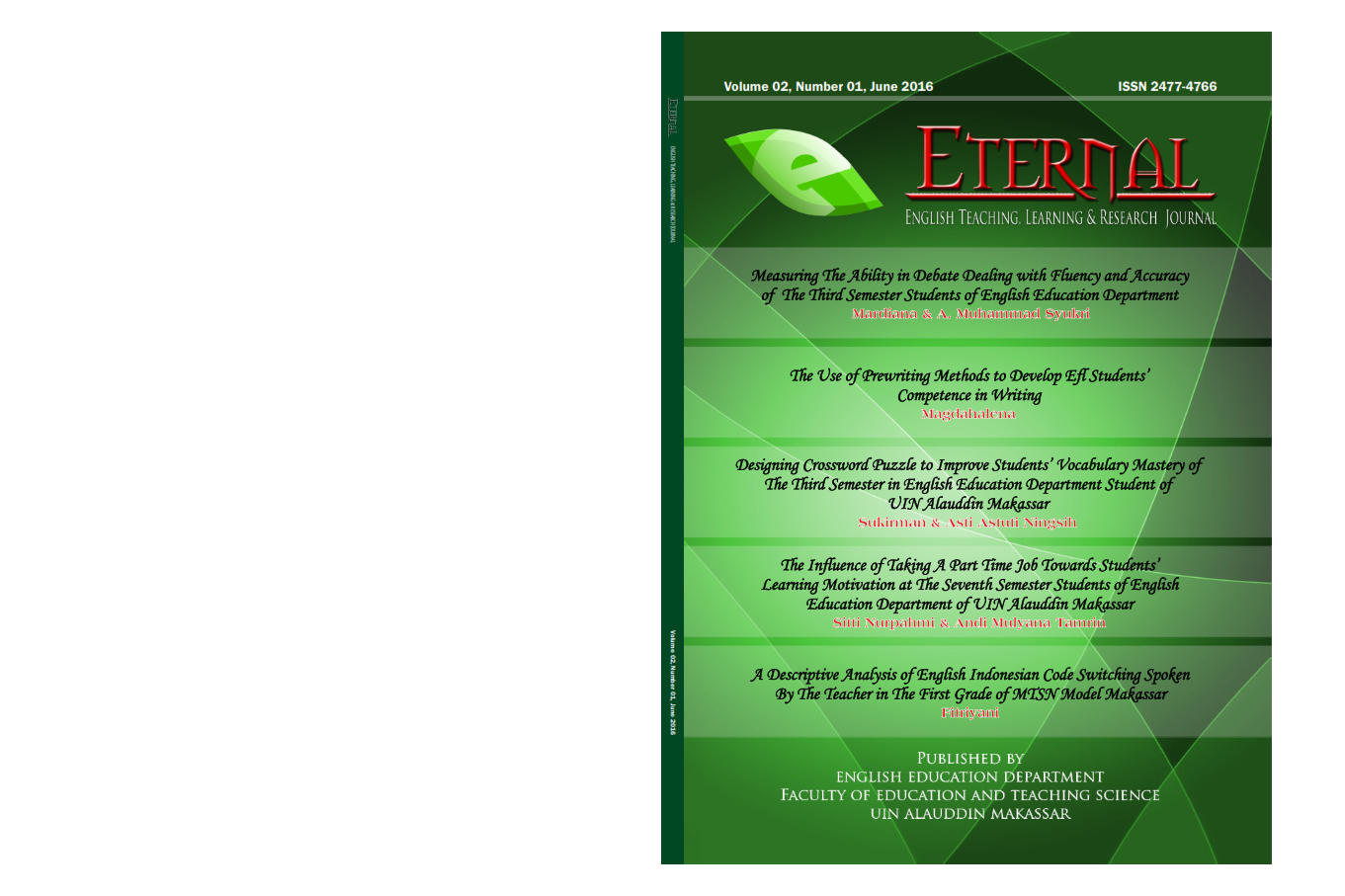THE USE OF PREWRITING METHODS TO DEVELOP EFL STUDENTS’ COMPETENCE IN WRITING
Abstract
The process approach becomes a choice for teachers to apply in the writing class rooms since this approach focuses on the connection of the writing topics to the students’ experiences which makes the writing tasks meaningful to students (Yan, 20014). In process approach, students’ composition is a product that should go through several stages: prewriting, writing, and post writing. In prewriting, there are several interesting activities that can be done in to improve students’ writing skill: asking questions, discussing an interesting topic, taking notes, free writing, clustering, brainstorming, grouping, doing buzy group, outlining, completing notes based on pictures, making a list, making idea map, categorizing, and classifying (Oshima and Hogue, 1997; Harmer, 2004, Huizenga, et al.,1990). Some research have proved the significant role of process writing to improve students’ skill in writing, Ho (2006) conducted a research on the effectiveness of using process approach in writing to primary school students of upper level and lower level through pre and post test, questionnaire, interview, and observation and found that process writing was able to develop the writing abilities and students’ attitude towards writing in all levels of students. Hasan & Akhand (2010) in their research combine the product approach and the process approach to teach ESL students in Bangladesh and revealed that the combination of the two approaches facilitate students to do writing tasks. Badger and White (2000) in Yan (2014) combine the process approach and the genre approach which he called process genre approach in their study and reported that this approach helped students study the relationship between purpose and form for a particular genre while they follow the stages in process writing: prewriting, drafting, revising, and editing. Using these steps develops students’ awareness of different text types and of the composing process.
Downloads
References
Mukminatien. (2004). Engaging EFL students in Indonesia with Athentic Tasks: Possibilities within Limitations. In English Language Teaching in East Asia Today. Changing Policies and Practices. Second Edition. Ho Wah Kam and Ruth YL Wong, eds. Singapore: Eastern Universities Press.
Yan, Guo. (2014). A process Genre Model for Teaching Writing. English Teacging Forum. Volume 43. No.4. Bureau of Educational and Cultural Affairs. Office of Engliah language Program.
O’Donnel, Teresa D. And Judith L. Paiva. (1993). Independent Writing. Second Edition. USA: Heinle & Heinle Publishers.
Md. Kamrul Hasan and Mohd. Moniruzzaman Akhand. (2010). Approaches to Writing in ESL/EFL Context : Balancing Product and Process in Writing Class at Tertiary Level. Journal of NELTA Vol. 15 No. 1-2. Desember 2010. Retrieved on July 2nd, 2014.
Brown, et al. (1984). Grammar and Composition. Boston: Houghton Mifflin Company.
Hadley, Alice Omaggio. (1993).Teaching Language in Context. Boston: Heinle and Heinle Publishers.
Belinda Ho. (2006) Perspectives: Working Papers in English and Communication17(1) Spring.
Osima, Alice and Ann Hogue. (1997). Introduction to Academic Writing. Second Edition. New York: Longman.
Huizenga, John, C.B.Snellings, and Gladys Berro Francis. 1(990). Basic Composition for ESL. An Expository Workbook. Third Edition. US: Heinle Thompson
Harmer, Jeremy. (2004). How to Teach Writing. England: Pearson Education Limited.
Copyright notice:
- Authors retain copyright and grant the journal right of first publication with the work simultaneously licensed under a Creative Commons Attribution License that allows others to share the work with an acknowledgement of the work's authorship and initial publication in this journal.
- Authors are able to enter into separate, additional contractual arrangements for the non-exclusive distribution of the journal's published version of the work (e.g., post it to an institutional repository or publish it in a book), with an acknowledgement of its initial publication in this journal.
- Authors are permitted and encouraged to post their work online (e.g., in institutional repositories or on their website) prior to and during the submission process, as it can lead to productive exchanges, as well as earlier and greater citation of published work (See The Effect of Open Access)

